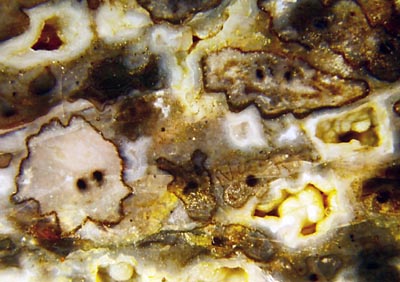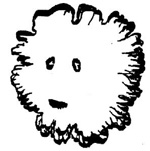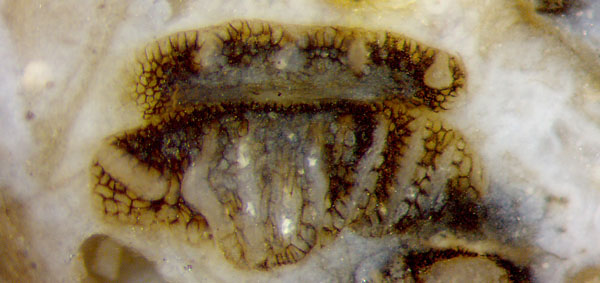
Nothia
What
is known as Nothia
now had been mistaken for small branches of
Asteroxylon
for decades.
(All the alleged Asteroxylon
sporangia in
Kidston's
slide collection at the Hunterian Museum, Glasgow, very probably have
to be re-interpreted, according to comparison with own samples, as
Nothia sporangia.)
It is still confusing to see these branches, and
small sporangia now assumed to belong to Nothia, more often than
expected associated with Asteroxylon,
and even immediately beside
Asteroxylon
cross-sections, while the very Asteroxylon
sporangia tend to be elusive.
After recognition as a separate species as late as
1964 [1], Nothia
was thoroughly described in 1979 [2] and 2001 [3]. Its
cross-sections are usually not circular because of numerous
mound-shaped emergences on the surface. (Note that any plant may appear
with a rugged outline in the chert as a result of shrivelling by drying
or fungus-induced shrinkage before silicification.)
Arrangement and
build of the sporangia suggest an affiliation with the zosterophylls.
However, there seem to be reasons to refrain from such conclusion,
among them the same
questionable reason for which Aglaophyton
had been widely separated from Rhynia,
namely the absence of a tracheid wall pattern of the proper type.

If among
odd-shaped cross-sections there are some with the central strand
once or twice divided and eventually looking like a funny
face, one can be
nearly sure it is Nothia.
One of them is suitable as a logo for the issues of Rhynie
Chert News.

Sporangia
with exceptionally well preserved structure suggest that the tubes
along the epidermis called
"giant cells" in [3] and thought
to be
"real cells" there, possibly are no such but early versions of
the poison tubes by which many flowering plants protect
themselves
against herbivores. (See
also Rhynie
Chert News 57, Figs.5-7.)
Annotation: Cross-sections of shrivelled Horneophyton can be
very similar to those of Nothia.
[1] A.G. Lyon:
Nature
203 (1964), 1082-83.
[2] W.El-S.
El-Saadawy, W.S. Lacey:
Observations on Nothia
aphylla,
Rev.
Palaeobot. Palyn. 27 (1979),
119-147.
[3] H. Kerp, H.
Hass, V. Mosbrugger: New data
on Nothia aphylla,
in:
P.G. Gensel,
D. Edwards (eds.): Plants Invade the Land, N.Y. 2001.


